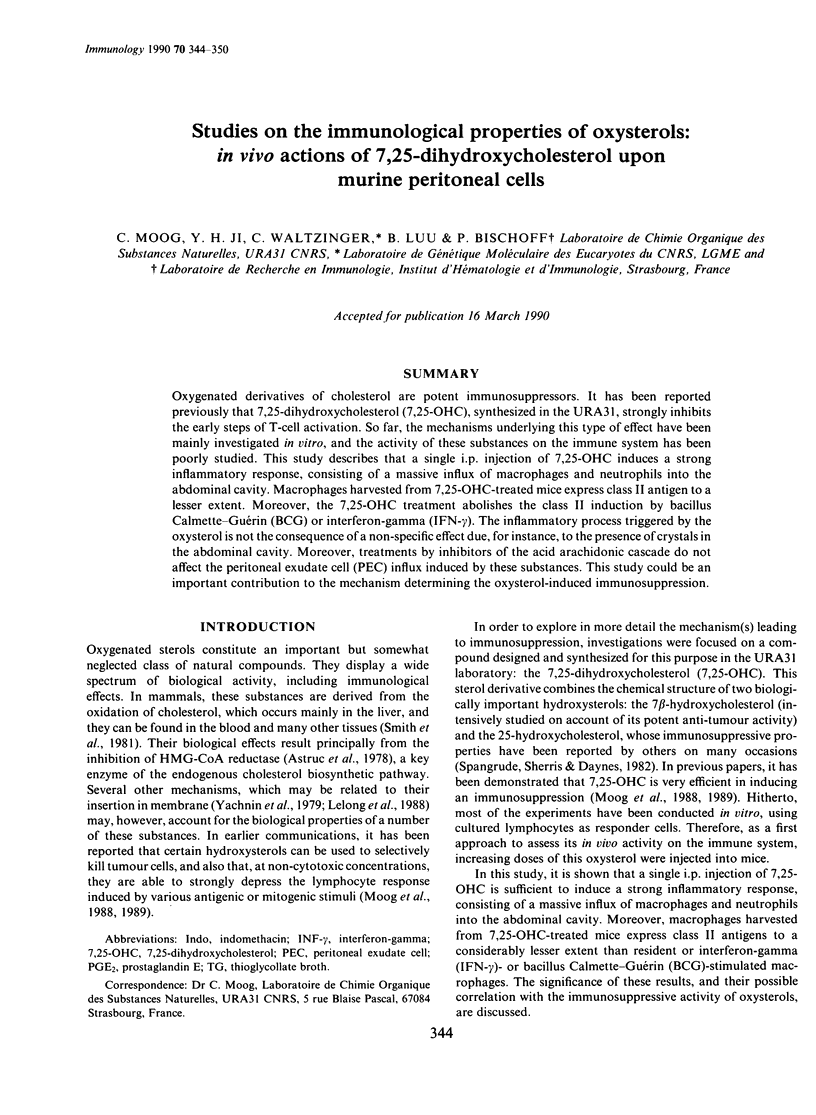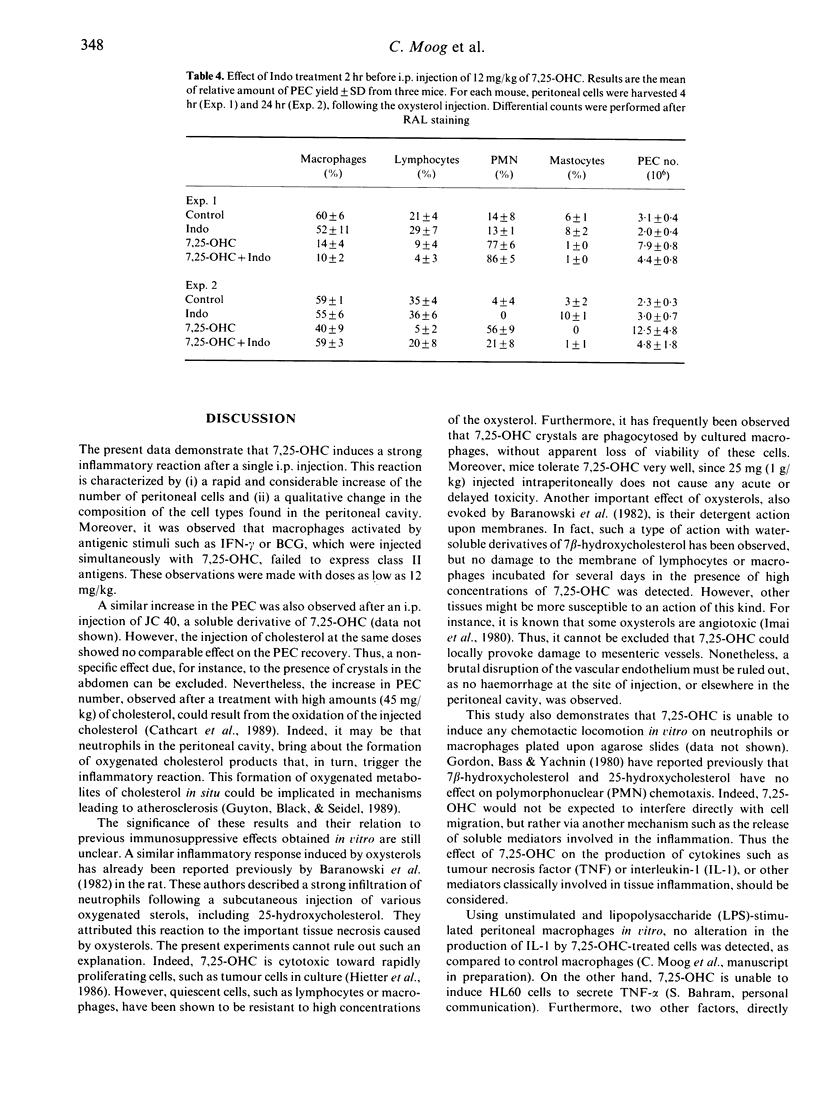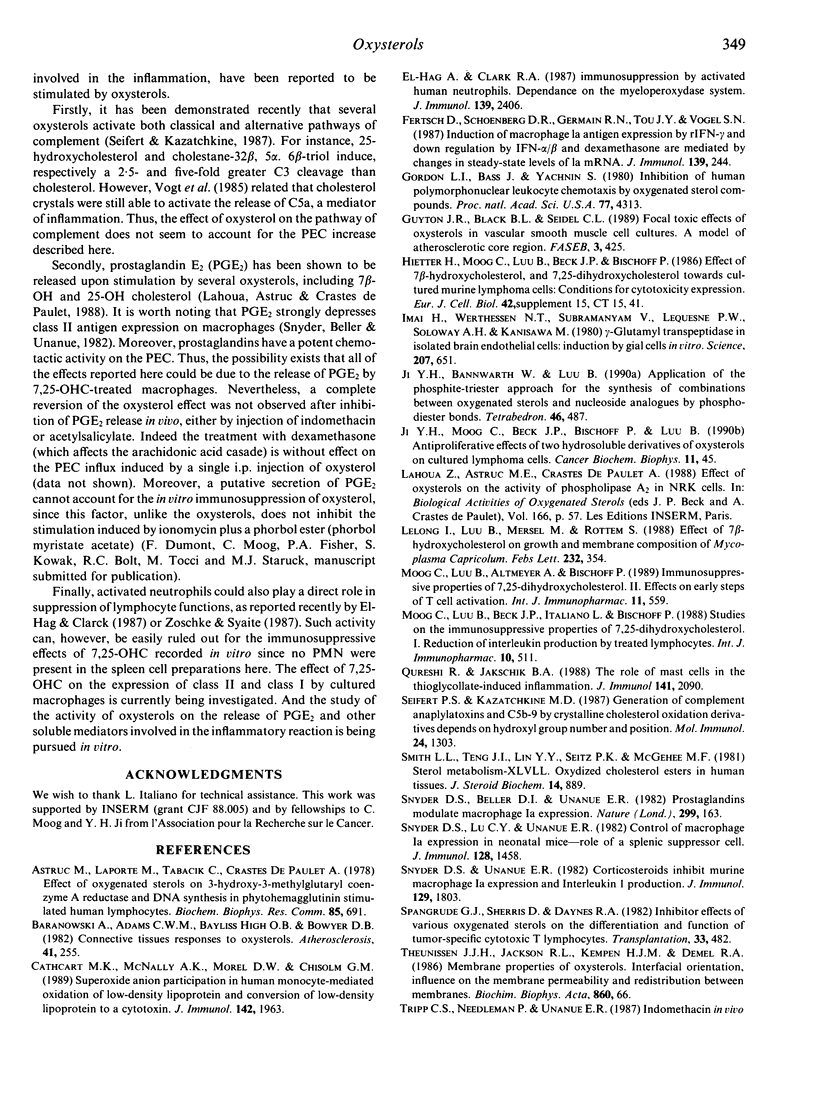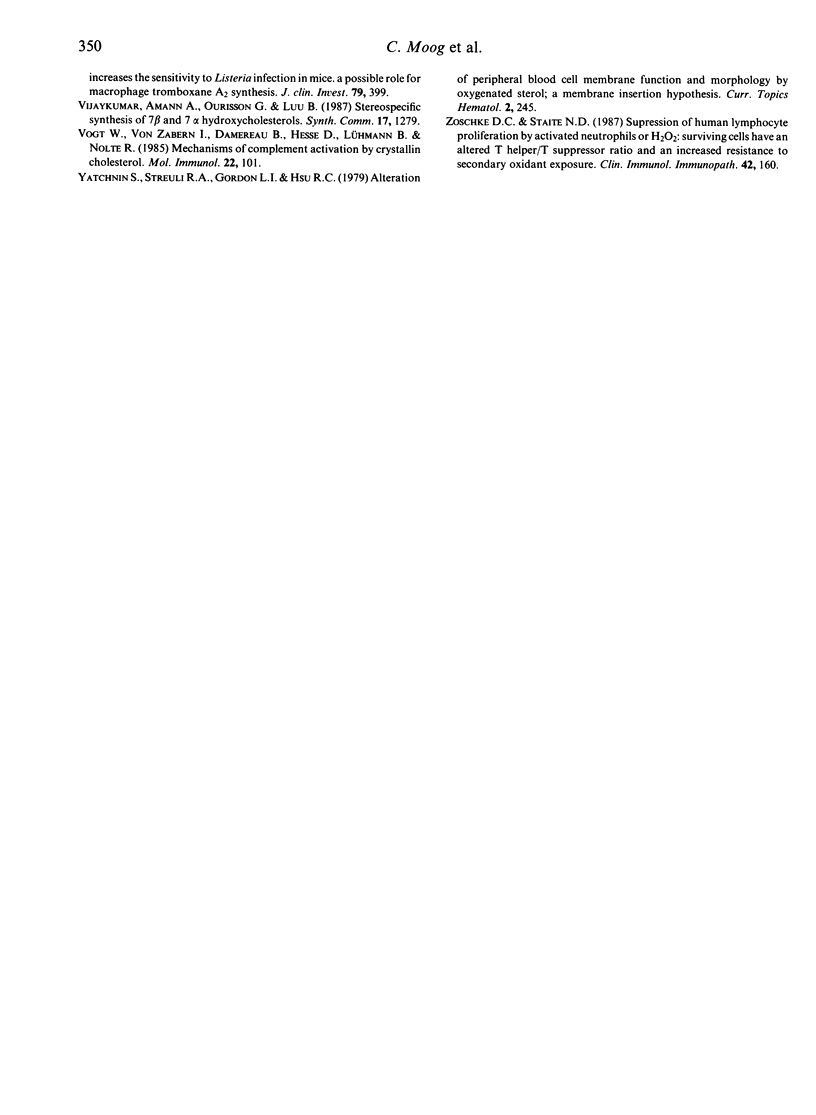Abstract
Oxygenated derivatives of cholesterol are potent immunosuppressors. It has been reported previously that 7,25-dihydroxycholesterol (7,25-OHC), synthesized in the URA31, strongly inhibits the early steps of T-cell activation. So far, the mechanisms underlying this type of effect have been mainly investigated in vitro, and the activity of these substances on the immune system has been poorly studied. This study describes that a single i.p. injection of 7,25-OHC induces a strong inflammatory response, consisting of a massive influx of macrophages and neutrophils into the abdominal cavity. Macrophages harvested from 7,25-OHC-treated mice express class II antigen to a lesser extent. Moreover, the 7,25-OHC treatment abolishes the class II induction by bacillus Calmette-Guérin (BCG) or interferon-gamma (IFN-gamma). The inflammatory process triggered by the oxysterol is not the consequence of a non-specific effect due, for instance, to the presence of crystals in the abdominal cavity. Moreover, treatments by inhibitors of the acid arachidonic cascade do not affect the peritoneal exudate cell (PEC) influx induced by these substances. This study could be an important contribution to the mechanism determining the oxysterol-induced immunosuppression.
Full text
PDF






Selected References
These references are in PubMed. This may not be the complete list of references from this article.
- Astruc M., Laporte M., Tabacik C., Crastes de Paulet A. Effect of oxygenated sterols on 3-hydroxy-3-methylglutaryl coenzyme A reductase and DNA synthesis in phytohemagglutinin-stimulated human lymphocytes. Biochem Biophys Res Commun. 1978 Nov 29;85(2):691–700. doi: 10.1016/0006-291x(78)91217-2. [DOI] [PubMed] [Google Scholar]
- Baranowski A., Adams C. W., High O. B., Bowyer D. B. Connective tissue responses to oxysterols. Atherosclerosis. 1982 Feb;41(2-3):255–266. doi: 10.1016/0021-9150(82)90190-3. [DOI] [PubMed] [Google Scholar]
- Cathcart M. K., McNally A. K., Morel D. W., Chisolm G. M., 3rd Superoxide anion participation in human monocyte-mediated oxidation of low-density lipoprotein and conversion of low-density lipoprotein to a cytotoxin. J Immunol. 1989 Mar 15;142(6):1963–1969. [PubMed] [Google Scholar]
- Fertsch D., Schoenberg D. R., Germain R. N., Tou J. Y., Vogel S. N. Induction of macrophage Ia antigen expression by rIFN-gamma and down-regulation by IFN-alpha/beta and dexamethasone are mediated by changes in steady-state levels of Ia mRNA. J Immunol. 1987 Jul 1;139(1):244–249. [PubMed] [Google Scholar]
- Gordon L. I., Bass J., Yachnin S. Inhibition of human polymorphonuclear leukocyte chemotaxis by oxygenated sterol compounds. Proc Natl Acad Sci U S A. 1980 Jul;77(7):4313–4316. doi: 10.1073/pnas.77.7.4313. [DOI] [PMC free article] [PubMed] [Google Scholar]
- Imai H., Werthessen N. T., Subramanyam V., LeQuesne P. W., Soloway A. H., Kanisawa M. Angiotoxicity of oxygenated sterols and possible precursors. Science. 1980 Feb 8;207(4431):651–653. doi: 10.1126/science.7352277. [DOI] [PubMed] [Google Scholar]
- Ji Y. H., Moog C., Beck J. P., Bischoff P., Luu B. Antiproliferative effects of two hydrosoluble derivatives of oxysterols on cultured lymphoma cells. Cancer Biochem Biophys. 1990 Jan;11(1):45–57. [PubMed] [Google Scholar]
- Lelong I., Luu B., Mersel M., Rottem S. Effect of 7 beta-hydroxycholesterol on growth and membrane composition of Mycoplasma capricolum. FEBS Lett. 1988 May 23;232(2):354–358. doi: 10.1016/0014-5793(88)80768-3. [DOI] [PubMed] [Google Scholar]
- Moog C., Luu B., Altmeyer A., Bischoff P. Studies on the immunosuppressive properties of 7,25 dihydroxycholesterol--II. Effects on early steps of T-cell activation. Int J Immunopharmacol. 1989;11(5):559–565. doi: 10.1016/0192-0561(89)90186-0. [DOI] [PubMed] [Google Scholar]
- Moog C., Luu B., Beck J. P., Italiano L., Bischoff P. Studies on the immunosuppressive properties of 7,25-dihydroxycholesterol--I. Reduction of interleukin production by treated lymphocytes. Int J Immunopharmacol. 1988;10(5):511–518. doi: 10.1016/0192-0561(88)90067-7. [DOI] [PubMed] [Google Scholar]
- Qureshi R., Jakschik B. A. The role of mast cells in thioglycollate-induced inflammation. J Immunol. 1988 Sep 15;141(6):2090–2096. [PubMed] [Google Scholar]
- Seifert P. S., Kazatchkine M. D. Generation of complement anaphylatoxins and C5b-9 by crystalline cholesterol oxidation derivatives depends on hydroxyl group number and position. Mol Immunol. 1987 Dec;24(12):1303–1308. doi: 10.1016/0161-5890(87)90125-8. [DOI] [PubMed] [Google Scholar]
- Smith L. L., Teng J. I., Lin Y. Y., Seitz P. K., McGehee M. F. Sterol metabolism--XLVII. Oxidized cholesterol esters in human tissues. J Steroid Biochem. 1981 Sep;14(9):889–900. doi: 10.1016/0022-4731(81)90238-7. [DOI] [PubMed] [Google Scholar]
- Snyder D. S., Beller D. I., Unanue E. R. Prostaglandins modulate macrophage Ia expression. Nature. 1982 Sep 9;299(5879):163–165. doi: 10.1038/299163a0. [DOI] [PubMed] [Google Scholar]
- Snyder D. S., Lu C. Y., Unanue E. R. Control of macrophage Ia expression in neonatal mice--role of a splenic suppressor cell. J Immunol. 1982 Mar;128(3):1458–1465. [PubMed] [Google Scholar]
- Snyder D. S., Unanue E. R. Corticosteroids inhibit murine macrophage Ia expression and interleukin 1 production. J Immunol. 1982 Nov;129(5):1803–1805. [PubMed] [Google Scholar]
- Spangrude G. J., Sherris D., Daynes R. A. Inhibitory effects of various oxygenated sterols on the differentiation and function of tumor-specific cytotoxic T lymphocytes. Transplantation. 1982 May;33(5):482–491. doi: 10.1097/00007890-198205000-00005. [DOI] [PubMed] [Google Scholar]
- Tripp C. S., Needleman P., Unanue E. R. Indomethacin in vivo increases the sensitivity to Listeria infection in mice. A possible role for macrophage thromboxane A2 synthesis. J Clin Invest. 1987 Feb;79(2):399–403. doi: 10.1172/JCI112825. [DOI] [PMC free article] [PubMed] [Google Scholar]
- Vogt W., von Zabern I., Damerau B., Hesse D., Lühmann B., Nolte R. Mechanisms of complement activation by crystalline cholesterol. Mol Immunol. 1985 Feb;22(2):101–106. doi: 10.1016/s0161-5890(85)80003-1. [DOI] [PubMed] [Google Scholar]
- Yachnin S., Streuli R. A., Gordon L. I., Hsu R. C. Alteration of peripheral blood cell membrane function and morphology by oxygenated sterols; a membrane insertion hypothesis. Curr Top Hematol. 1979;2:245–271. [PubMed] [Google Scholar]
- Zoschke D. C., Staite N. D. Suppression of human lymphocyte proliferation by activated neutrophils or H2O2: surviving cells have an altered T helper/T suppressor ratio and an increased resistance to secondary oxidant exposure. Clin Immunol Immunopathol. 1987 Feb;42(2):160–170. doi: 10.1016/0090-1229(87)90003-1. [DOI] [PubMed] [Google Scholar]
- el-Hag A., Clark R. A. Immunosuppression by activated human neutrophils. Dependence on the myeloperoxidase system. J Immunol. 1987 Oct 1;139(7):2406–2413. [PubMed] [Google Scholar]


